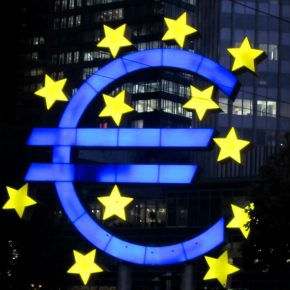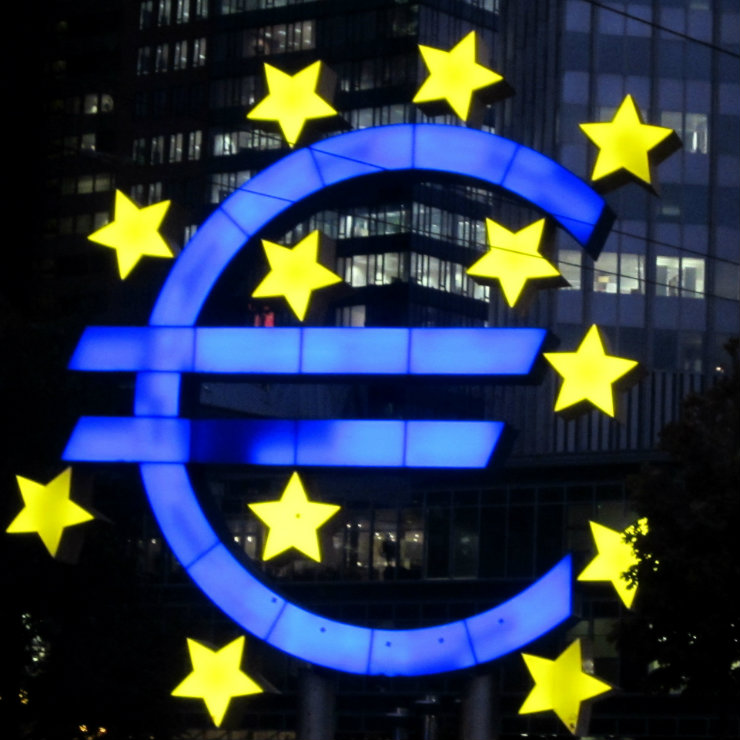Tydzień w gospodarce
Category: Trendy gospodarcze

ECB HQ, Frankfurt am Main, Germany (Stephanie Jones, CC BY-NC-SA 2.0)
Moreover, the debate concerning the possible entry has not fizzled out, but is still raging on among politicians and economists. Many of them — especially the representatives of the so-called economic mainstream — have recently argued that Poland should enter the Eurozone as soon as possible if it wants to maintain its political position within the European Union (EU). They also repeated the old arguments for the adoption of the EUR — such as the lower transaction costs or the reduced exchange rate risk. They pointed out that Poland would surely fall under Russia’s control if it didn’t adopt the EUR. Others are indicating that Poland should be declaring its desire to adopt the single currency, but at the same time postponing the accession itself for as long as possible.
The Economic and Monetary Union was established more than two decades ago as a great economic, financial and political project, which proved to be a painful experiment for many participating countries. The introduction of the EUR was supposed to provide economic benefits — thanks to the reduction of transaction costs, elimination of the exchange rate risk, stability and transparency of prices and increased investments resulting from the lower interest rates. The European Commission claimed that the long-term increase in the rate of economic development resulting from the introduction of the EUR would reach up to 1 per cent of additional GDP growth per year.
It turned out, however, that the Eurozone deprives countries of the ability to manage their own economies in times of crisis. As a result, instead of accelerating economic growth, the common currency generated additional costs and triggered processes that ultimately deepened the disparities in the economic development between the affluent countries of Northern Europe and the countries of the South, which are becoming poorer. Therefore, instead of deeper integration the EUR created a strong source of opposition to the very idea of European integration.
The promises of increased investments thanks to the Eurozone never materialized. Meanwhile, the equalization and the actual reduction of the interest rates in many countries, thanks to the introduction of the EUR, turned out to be a trap.
The interest rate, as the main component of the cost of capital, should reflect the level of risk associated with a given investment. It should be adapted to the ongoing changes in the macroeconomic situation. Unfortunately, the Eurozone’s uniform interest rate, which is too low for some countries, has led to excessive consumption and economically unjustified investments. Cheap credit turned out to be a trap for the economies of Southern Europe. It led to the development of a speculative bubble in the real estate market, and to growing levels of corporate and household debt. At the same time, the Economic and Monetary Union has deprived the individual member states of the ability to autonomously balance their economies by influencing the interest rates and the currency exchange rates.
As a result, many Eurozone countries, unable to depreciate their currency in order to restore their companies’ competitiveness during the crisis, were forced to introduce socially corrosive cuts in public spending, raise taxes and reduce wages. All of this has contributed to the multi-annual economic stagnation in the countries of Southern Europe.
The Economic and Monetary Union has generated permanent external economic imbalances in the countries of the Eurozone. Since its creation, some countries — mainly from the southern part of the Eurozone — have been running current account deficits, while other countries, mainly from the northern part of the Eurozone, including Germany, have been recording persistent surpluses.
The reason for the persistence of such imbalances is the fact that the EUR is a currency that is too strong for the latter group of countries and too weak for the former group. The only option is the economically costly process of fiscal policy tightening, which undermines economic growth and hurts household incomes. It would be possible to introduce mechanisms in the Eurozone that would equitably spread the costs of correcting the emerging imbalances between the two groups of countries. However, the countries recording the external surpluses, which are benefiting from the existing situation, do not agree to the introduction of such mechanisms.
The Eurozone has never been the optimum currency area and will not become one in the foreseeable future. The economies forming such an area should have similar business cycles, should react similarly to external supply and demand shocks, while the flexibility of prices and wages in these countries should be similar and should be rather high. Unfortunately, this is not the case. Consequently, the EU area has been and will remain exposed to strong asymmetric reactions to supply and demand shocks. The Eurozone still hasn’t developed the appropriate mechanisms for conducting the optimal monetary and exchange rate policies for its member states. As a result, membership in the zone is associated with a very high risk.
The pragmatic scepticism towards the adoption of the EUR, which has characterized Poland’s policy since its accession to the European Union in 2004, has proven to be an asset. It has allowed Poland to pass through the crisis period relatively unscathed. And thanks to this attitude, the cost and wage adjustments occurring during the crises were not as burdensome for the Polish citizens as in some of the Eurozone member states.
Looking back, the value obtained from this approach could be estimated to reach tens, if not hundreds of billions of EUR. This is the amount that Poland did not lose thanks to the ability to implement an autonomous monetary and exchange rate policy. This fact should be emphasized particularly strongly now, as the end of 2018 brought a visible slowdown in the growth of the EU economy, and the forecasts for 2019 and 2020 indicate that another crisis cannot be ruled out.
The sovereignty of monetary policy and exchange rate policy played an important role in the process of convergence with the most developed EU countries. However, this process is far from being over and in terms of the level of economic development Poland is just catching up with the countries of Southern Europe. Polish exports are diverse and growing, but are still dominated by less technologically advanced goods. The competitiveness of Polish industry is still based on the relatively low labor costs. Therefore, Poland still resembles the southern countries of the Eurozone more than the affluent northern countries.
In the coming decade the transfers from the European Union to Poland will be reduced. After 2027, it may even happen that the value of contributions paid to the EU budget will be equal to the value of funds that Poland receives from the EU. It is possible that the Polish economy will be strong enough to enter a path of a long-term growth without the support from the EU funds. However, it may be expected that there will be a period in which the reduction of the transfers from the EU will create external imbalances and will hurt the economic growth. In such a situation, it would be better for Poland to have the options provided by an autonomous exchange rate policy and monetary policy.
Price stability, low interest rates and healthy public finances are a value in itself, and therefore Poland should strive to fulfil the criteria for joining the Eurozone. Poland may declare its desire to enter the Eurozone at an unspecified future date. It could be politically costly to openly reject the accession to the Eurozone after the previous commitment to adopt the single currency. Nevertheless, Poland is currently in a very favorable position, remaining outside the Eurozone and having the ability to observe and critically analyze the course of the Eurozone reforms, as well as the internal economic adjustments in the individual member states. This is a unique opportunity to draw conclusions for the Polish economic policy — both at domestic and European level.
It seems that for the time being, the best policy that Poland can implement towards the Eurozone is to maintain the pragmatic skepticism with regard to a speedy adoption of the EUR and to declare the desire to enter the Eurozone, without providing any specific dates and making any specific commitments. A quick adoption of the single currency will not become a miracle cure for the challenges the Polish economy faces. It will not trigger a developmental impulse, as some have argued. It will not magically strengthen Poland’s position in the European Union — just as it does not strengthen the position of the weak economies of Southern Europe. Conversely, it will expose Poland to the risk of walking into a trap in which the southern countries of the Eurozone have been stuck for more than a decade, or the risk of bearing the costs arising from the lack of effective reforms of the Eurozone. Consequently, staying outside the Eurozone still remains a more comfortable option than entering it.
Mariusz-Jan Radło, PhD, is an Assistant Professor at the Warsaw School of Economics



